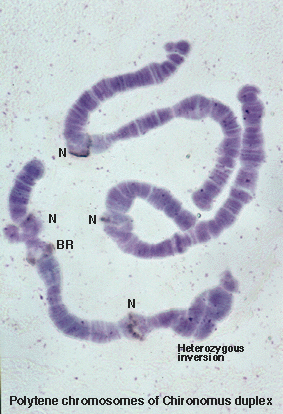Polytene Chromosomes
In some cells of the larva, and to a lesser extent of the adult, the chromosomes continually divide while the cell itself does not, ie. the cell essentially becomes polyploid. This is called endomitosis.
 However, the multiple copies of each chromosome remain closely paired and grow larger and larger. These then are polytene (many thread) chromosomes. In Chironomus the chromosomes go through 14 such endomitoses, resulting in a chromosome of 8192 threads (or about 16000 in the closely paired visible chromosome) (Daneholt and Edström 1967).
However, the multiple copies of each chromosome remain closely paired and grow larger and larger. These then are polytene (many thread) chromosomes. In Chironomus the chromosomes go through 14 such endomitoses, resulting in a chromosome of 8192 threads (or about 16000 in the closely paired visible chromosome) (Daneholt and Edström 1967).
The main reason for the evolution of these highly replicated chromosomes appears to be to meet the need for very large quantities of gene product from a small number of genes, which appear as swollen or puffed regions on the chromosome. It appears that it is easier to duplicate the whole chromosome complement than to replicate just the specific genes required.
Each chromosome shows a series of bands where the DNA is more dense due to coiling of the DNA. These bands form a unique pattern that allows a specific chromosome or chromosome arm to be recognized in different cells of the same tissue, different individuals of the same species, or even in different species of the same genus. The banding pattern also allows us to recognize regions in which an inversion has occurred. If one member of the chromosome pair carries the normal (or Standard sequence) and the other the inverted sequence, it is possible to observe a loop formed so that the homolgous bands of the chromosome can pair.
In the larva, polytene chromosomes are found in the cells of the salivary gland and of the Malpghian tubules. The salivary glands produce the silk that the larvae use tomake their tubes. The major genes involved in producing silk are the Balbiani Ring (BR) genes. The cells also require ribosomes to process the gene products and these are composed of ribosomal proteins produced in the nucleolus or nucleoli (N).
The photograph shows the polytene chromosome set of the Australian species Chironomus duplex, in which many of these features can be observed.
REFERENCE:
Daneholt, B, and Edström, J. E. (1967) The content of deoxyribonucleic acid in individual polytene chromosomes of Chironomus tentans. Cytogenetics 6: 350-356.
Return to The Organism
Modified: 18 February 2016
Access: Unrestricted
Copyright © 2005-2016, Jon Martin.
 However, the multiple copies of each chromosome remain closely paired and grow larger and larger. These then are polytene (many thread) chromosomes. In Chironomus the chromosomes go through 14 such endomitoses, resulting in a chromosome of 8192 threads (or about 16000 in the closely paired visible chromosome) (Daneholt and Edström 1967).
However, the multiple copies of each chromosome remain closely paired and grow larger and larger. These then are polytene (many thread) chromosomes. In Chironomus the chromosomes go through 14 such endomitoses, resulting in a chromosome of 8192 threads (or about 16000 in the closely paired visible chromosome) (Daneholt and Edström 1967).